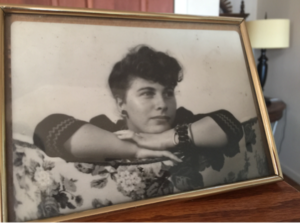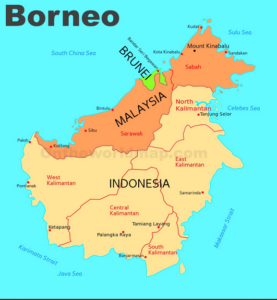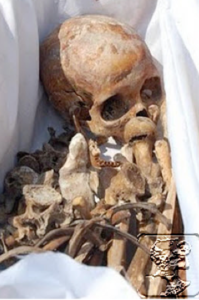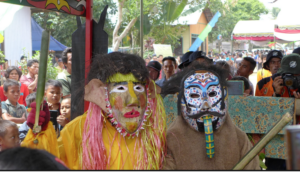The Tiwah
American society doesn’t prepare us very effectively for the death of our parents. Maybe we’ve attended a few funerals, sent flowers, or mailed some condolence cards with our sentiments. Perhaps we’ve seen films showing what other people in our culture have gone through. In short, we’ve brushed up against others’ grief. But when we are confronted with our own parent’s death, we find it to be something we just are not prepared for.
In late 1995, I was beginning work on a film in Israel when word arrived that my father had suddenly passed away. He was 95, but I was in shock, convinced he’d outlive me. I returned immediately to Washington D.C. where my family shared a house with him on Macomb Street in Cleveland Park. Much of what happened during those two or so weeks immediately following his death was mostly a blur.
Then there was my mother. In 1968, almost thirty years prior to my father’s death, my mother took her own life: a fact that was discussed little over the years. I remember the same shock followed by a similar, almost endless blur.


A couple of weeks after the funeral for my father had come and gone, it started to hit me that my father was in fact no longer living in the house with us.
Around that time, a project that I had been talking with National Geographic about that sounded fascinating came through and I agreed to get involved. My thinking included the hope that my involvement in a film might keep me from thinking too much about my own private mourning. Some people talk with family or a therapist: I look around for a good film project.
The film would take me to the Indonesian side of Borneo for a documentary about a mysterious and colorful month-long ceremony called a Tiwah that from its description looked like one long funeral ritual. Just what the doctor ordered!

Borneo is in Southeast Asia and is the third largest island in the world. It is occupied by part of Indonesia and Malaysia and is surrounded by exotically named places like Sumatra, Bali, Sulawesi, and Java. Largely due to the remoteness of where it is practiced, in Central Kalimantan province, few outsiders have ever heard of a Tiwah and even fewer can claim to have seen one or come away understanding it.
The timing for such a project about celebrating death, made theoretical sense to me — what with the recent loss of my father. But I had no idea that documenting such an exotic custom like this on the other side of the world might inform my own sense of grief and ultimately assist me in coming to terms with my own loss.
Our goal was to follow Anne Schiller, an American anthropologist who had worked for years among the Dayak people. The Tiwah was part of her focus about which she had become a kind of expert.
Tiwah is the name given to this month-long festival for the dead, avidly performed by families of the recently departed with the goal of bestowing blessings on the dead and to the larger Dayak community. It’s a kind of last rights Hindu-esque series of spiritual activities involving animism and ancestor worship. Some of it resembles our American Halloween – only Tiwah is Halloween on hallucinogens. And, with better costumes. Like Halloween, it is believed that the spirits of the dead are all around during this time. Only, instead of the goal being to get more candy than your brother or sister, the notion central to Tiwah is that it is up to the living to clear a pathway for the souls of the departed to reach their final place in heaven.
There was a little bit of something for everyone in the Tiwah.
It was joyous and somber at the same time, with ritualistic ceremonies all day and night, lots of chanting, music and dancing, fire and smoke, ritual baths, trances, mock battles. There were sacrifices of cows and chickens, and lots of great food — all designed to honor and please the ancestral spirits whose job it was to guide the dead on their final journey. And, did I mention the drums? Lots of drums. Oh, and gongs too.
Participation in Tiwah wasn’t just a choice the way we understand choices in our culture: it’s a requirement. As Anne explained to us, “On our side of the world, it’s believed by many that getting into heaven is based on one’s own merit. If you were good: you get in. If you weren’t so good, you don’t.” In Dayak culture, it’s believed that the only way you get there is if your children do this ritual for you.
Part of the tradition includes burying the dead twice.
It goes like this. When someone in the community dies, their family buries them temporarily in the ground where they are kept in a kind of holding pattern until the community as a whole can perform a Tiwah. Prayers and songs accompany this temporary burial, designed to protect the souls of the dead while they wait underground.
The idea is that when enough people have died in the community since the previous Tiwah, and when enough money has been raised collectively by the families to afford it, the village headman will announce and schedule a Tiwah. But, alas, the waiting time for the next Tiwah can sometimes go slowly, taking years for a Tiwah to be called. Sometimes decades.
Once a Tiwah begins, the first step requires families locate and unearth their loved ones waiting patiently in the ground. The locations of the graves in the rainforest are often chosen spontaneously at the time of death and are often poorly marked. If years have passed, the forest floor will be deeply covered in thick growth covering previous trails and making the burial spots hard to find.

The first day that we arrived in the village, we found ourselves bounding thru the jungle trying to keep up with eight members of a family searching for their temporary grave for a man named Belawan who had died five or six years earlier. At first, the family seemed sure that they knew just where the grave was located, so I wasn’t prepared for what happened.
Alas, there was no grave where they originally thought for sure Belawan might be buried, and, as each new spot proved not to be right either, we all became increasingly concerned that Belawan might never be found. We chased around for more than two hours, passing other family groups trying to locate their own loved ones’ burial sites.
At one point, we found ourselves grouped in a circle, surrounded by heavy vegetation with only the sounds of insects, distant chanting, and our own heavy breathing. I wondered if the spirits were watching our folly from above and looking down at us disapprovingly. Or, were they laughing? Suddenly, a shout rang out and we all knew instantly that someone had located our Belawan.
Discovering the grave proved to be quite moving for everyone — including me. After a few strokes of the shovels, and to everyone’s relief, we found ourselves face-to-face with Belawan’s remains. I’m not sure what I was expecting, but I wasn’t prepared for there to be an actual skeleton in there. We don’t stumble across a lot of human skeletons in our average daily travels. What little remained of Belawan’s clothes were in tatters, almost nonexistent. His bones were encrusted with dirt and plant roots.
As they slowly lifted his bones now scattered and disconnected out of his grave, they passed them carefully around for everyone to examine. More tears of sadness and joy.
What came next was another surprise. It seemed that a few personal possessions belonging to the deceased were often added into their graves at the time of the first burial — objects that were meaningful to the deceased — like photos of them with family members or maybe a piece of jewelry. Each object, upon discovery, inspired memories and lots of stories. At one point, a well-worn kitchen pot was dusted off and lifted out of the grave encouraging Belawan’s younger brother to tell a story about Belawan’s love for cooking. More tears. I could tell his was a humorous story that all enjoyed hearing. My father loved to tell jokes and enjoyed watching people laugh at them.
I would have thought that the memories of their loved one would bring sadness and feelings of loss. But this unveiling of sorts clearly inspired stories and laugher. Having the bones of your dear sister or husband or father in your hands was certainly something uncommon in our part of the world. Seeing it them being passed around this intimate circle seemed perfectly normal. I loved Belawan’s family.

While this was happening, a few family members carefully gathered all the bones, lovingly cleaned them and placed them into a wooden box designed for the purpose. Over the next few days, the bones would be prayed over, washed, cleaned more, dusted with baby powder and eventually placed in a much larger bone repository called a Sandung . Eventually, Belawan’s bones would be joined with his ancestors’ in a large above-the-ground beautifully painted Sandung at the culmination of the Tiwah.
Many western families might have family plots where everyone would be buried side-by-side, but this Dayak idea of putting all the bones together in a large collective box resembling a house with windows and doors took the notion of being together to a new level.
In the Dayak vision of the afterlife, all the ancestors reunite in a place they call the Prosperous Village. There, they fish together, herd livestock and they hold more feasts and celebrations. But in order for them to all join together in the Prosperous Village in the first place, surviving family members back on the earthly plain must cooperate together to make it happen. That’s Tiwah.
Without the community’s efforts, the souls of their departed would not make it to the Prosperous Village where “the rivers are filled with fish and no one goes hungry.”
Because family members are responsible in this way, there is an unbreakable link between living and dead that continues to bind generations together. Anne suggested that the importance of the Tiwah to the Dayak culture has encouraged families to stay unusually close to each other thru generations in life as well as in death.

What was it about this event that was so moving to me? Surely not the animal sacrifices. Nor the way those gods seemed to enjoy spicy food. (Not my thing.) But being there to observe the event gave me a rare window through which to observe a wonderfully human and generous tradition. Surrounded by the amazing dancing and drumming and incense and chanting and watching priests go into trances and lots of people in masks, I felt strangely at home.
The experience of mourning seems to be largely a universal one among humans and some animals too. The Tiwah is just one of many rituals like it among cultures around the world that connect us to our departed loved ones. At home, we light candles to honor the anniversary of someone’s death. The Vietnamese celebrate Tet each year and, as with the celebration of the Day of the Dead in Mexico, generations of departed loved ones are honored. It is as if a veil is lifted and we can reach across the gap to commune with loved ones who have departed from our world.
The notion that we are all connected in ways that we will never know or fully understand is not unique to the beliefs of the Dayak people. And while our western traditions might not go as far as theirs, something magical is surely in the air amid the wispy incense, the chanting, and the music.
The film that National Geographic put together in the editing room was disappointing. It relied heavily on the strangeness of the whole event and, in my opinion, missed its real beauty by cloaking it is strangeness. The producer who was along for the filming, kept trying to get Anne to talk about the not so distant past when Tiwah was reportedly associated with cannibalism and sacrifices of humans rather than animals. She kept refusing to respond.
Animal sacrifices were performed during the week. I decided to film this part of the Tiwah with my camera set to shoot at six frames per second instead of the usual 24. The resulting images of killing and blood were softer on the eyes of an audience watching on the other side of the world making the moments appear blury and more visually abstract.
The first reaction — maybe a lasting one — at seeing a Tiwah can easily seem strange. Spicing up the story and talking about cannibalism in the film just at a point before cutting away to a commercial break would entice viewers to come back to continue watching the film after the break. To my thinking, Geographic put out a film that managed to see the ritual of the Tiwah through somewhat frightened and distorted eyes, effectively

demeaning much of the beauty and spirit of the whole event.
One of the reasons that I began to distance myself from National Geographic during those years was because of the way they began distorting stories in this way out of a need, perhaps, to increase the viewership. I can’t really blame them; they surely had their reasons.
New York Magazine had an announcement for the film in their entertainment section in which they recommended people watch the show when it aired. What was written speaks to my concerns:
Borneo: Beyond the Grave sends red-haired anthropologist Ann Schiller
to deepest Indonesia, where she will be adopted into the Ngaju Dayak
tribe of ex-headhunters and participate in reburial rituals that involve
grave robbing, skull-scouring, bloodsucking, animal sacrifice, honeybees,
masks and drums. You’ll like her.
In quieter moments as Anne and I were getting to know one another in the days of filming, she would talk with such respect about the beauty and the grace of the entire Tiwah.

Being around the rituals helped me to connect to my own father’s recent passing and helped soothe my private mourning process. Is there a Prosperous Village somewhere that all our mothers and fathers might be sitting around talking or playing cards or a few rounds of golf together? I don’t know. It’s a little hard to imagine how that might work. But being surrounded by so many people engaged in the Tiwah who obviously thought this to be true was deeply comforting to me.
At several times during the filming process, I would feel particularly close to my father. And the experience began a special on-going connection that I have to him and my mother and to others who have died in my life. Different things would set off the connection to them while we were there. It might be the way the smoke of a piece of incense waved in the air or the sound of prayer in the morning when I was waking up or going to sleep.
Here at home, I’ve brought out family photos and placed them around the house. In a similar way the afternoon light bouncing around in our dining room connects me to the subjects of those portraits.
The right physical and spiritual forces came together for me in Borneo. And I have to admit that my own camerawork on that film was inspired too, probably better than anything I had done before or since.
I will never forget how beautiful it was to watch the family of Belawan as they cleaned his bones and then covered them in powder. Nothing in the ceremony touched me quite as much as this simple and intimate act.
Tiwah had a gentle, lasting effect on me. I felt connected to the Dayak people, their losses, and their love and respect for the departed. And I found great solace and much to ponder in their belief in an invisible connection that was so much bigger than their visible experiences in the material world. It is rich and complex and intensely human.
Anne said it best. “Whenever I leave this place, I come away with a heightened sense of awareness about my family and my community and how very interdependent we are and how we really do need to take care of one another.”



Beautiful Reuben. Thank you for taking me there with you.
Nice article, BUT… why did you use one of my photographs (from http://www.jokar.com.au/blog/bangkal/) without asking permission or even giving attribution? It is presented as if it was your own work. That is not nice.
I am so so sorry. I wasn’t presenting the photo as my own, but certainly “borrowed” it from you.
What would you like me to do? Take it down? give you a photo credit?
Again, I’m really sorry.
r
It’s kind of late to be responding, but… better late than not at all? I ask you to REMOVE MY PHOTO that you have appropriated from your blog. (I would have thought that would be the obvious ethical action…)
As an aside: if you were there filming a Tiwah over a period of a month, how come you don’t have any photos (or video stills) of your own to put in our blog?
Can I vindicatory say what a assist to conceptualise someone who actually knows what theyre talking nearly on the internet. You definitely know how to carry an take to featherlike and get it alpha. More group demand to interpret this and realize this view of the news. I hokum consider youre not many popular because you definitely soul the heritage.
Thank you!
You are so interesting! I do not consider I get translate anything same that before. So great to make somebody with a few model thoughts on this store. Earnestly.. thanks for play this up. This computer is something that’s requisite on the web, someone with a bit of originality!
Thank you!
I have been browsing online greater than 3 hours nowadays,
but I never found any attention-grabbing article like yours.
It is lovely price sufficient for me. Personally,
if all site owners and bloggers made just right content as you
did, the net might be a lot more useful than ever before.
such a nice comment.
thanks so much.
makes my day too!
I became honored to receive a call from a friend immediately he observed the important recommendations shared on the
site. Reading through your blog post is a real brilliant experience.
Many thanks for considering readers at all like me, and I would like for you the best
of success like a professional in this field.
thank you so much..